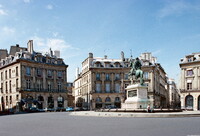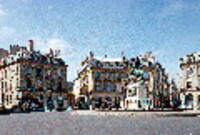| dc.coverage.spatial | Site: Paris, Île-de-France, France | en_US |
| dc.coverage.temporal | 1685 (creation) | en_US |
| dc.creator | Mansart, Jules Hardouin | en_US |
| dc.creator | Bosio, François-Joseph, Baron | en_US |
| dc.date | 1685 | en_US |
| dc.date.accessioned | 2012-12-20T20:37:54Z | |
| dc.date.available | 2012-12-20T20:37:54Z | |
| dc.date.issued | 1685 | en_US |
| dc.identifier | 179607 | en_US |
| dc.identifier.other | archrefid: 2079 | en_US |
| dc.description | General view, from northeast; Other works by Hardouin Mansart in the 1680s included his urban plans for Paris. For the buildings surrounding the circular Place des Victoires (1685; altered 1692), Paris, he used the traditional Italian façade design of a giant pilaster order over a rusticated, arcaded ground floor. These were capped with sloping slate mansard roofs, punctuated by dormer windows. By 1692, the Place des Victoires was pierced by six streets, and the circular plan functioned as a joint that harmonized their several axes. The focus of the circular Place is now the equestrian monument in honor of King Louis XIV (celebrating the Treaties of Nijmegen concluded in 1678-1679) by Bosio (1822). The original sculpture of the king by Martin Desjardins was destroyed in 1792. Source: Grove Art Online; http://www.oxfordartonline.com/ (accessed 7/15/2010) | en_US |
| dc.format.medium | stone; bronze | en_US |
| dc.rights | © Scott Gilchrist, Archivision, Inc. | en_US |
| dc.subject | architecture | en_US |
| dc.subject | rulers and leaders | en_US |
| dc.subject | City planning | en_US |
| dc.subject | Louis XIV, King of France, 1638-1715 | en_US |
| dc.subject | Seventeenth century | en_US |
| dc.title | Place des Victoires | en_US |
| dc.type | image | en_US |
| dc.rights.access | Licensed for educational and research use by the MIT community only | en_US |
| dc.identifier.vendorcode | 1A1-HMJ-PDV-A3 | en_US |
| dc.contributor.display | Baron François-Joseph Bosio (French sculptor, 1768-1845); Jules Hardouin Mansart (French architect, 1646-1708) | en_US |



